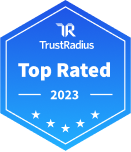Predictive Analytics Software

Top Rated Products
(1-4 of 4)
All Products
(51-75 of 174)
Explore recently added products
Predictive Analytics Software TrustMap
TrustMaps are two-dimensional charts that compare products based on trScore and research frequency by prospective buyers. Products must have 10 or more ratings to appear on this TrustMap.
Learn More About Predictive Analytics Software
What are Predictive Analytics Tools?
Predictive Analytics tools are used to analyze current data and historical facts in order to better understand customers, products, and partners. They are also used to identify potential risks and opportunities. Predictive analytics platforms tend to be very complex products and require advanced skill sets in order to use them effectively.
In the hands of skilled data analysts and data scientists, predictive analytics can be an extremely powerful tool. It can, for example, calculate customer lifetime value for a given customer; estimate sales projections for the next quarter, or predict what product an online shopper is likely to purchase next.
Predictive analytics tools make these analyses much easier and more accessible for organizations. They make leveraging disparate data sources into single analyses a lighter manual load. Predictive analytics platforms can standardize or even automate some repeated analyses. Intelligent analytics engines can also make new or ad hoc analysis more accessible for technical and business analysts alike. These tools lower the barrier to entry for many non-specialized users, although this is not universal across all analytics platforms.
What is Predictive Analytics?
Predictive analytics explore, process, and aggregate historical data, then apply various predictive modelling techniques to determine potential future outcomes. Predictive analytics help users and organizations better understand what is likely to happen in the future, based on what has occurred in the past.
Predictive analytics is one of the more advanced forms of business analytics. It fits within this range of analysis types available to organizations:
Descriptive analytics: provides a real-time view of what is occurring right now. Current stock prices are one example of descriptive analytics.
Diagnostic analytics: These analyses help explain why or how something occurred or is currently happening.
Predictive analytics: These analytics use descriptive or diagnostic data to determine future outcomes.
Prescriptive analytics: These help guide what should be done to create a given outcome.
Predictive analytics can often overlap or evolve into prescriptive analytics. The functional difference is how the analytics tool is utilized or deployed. Predictive analytics can also be used prescriptively to inform other business decisions, either via standardized reporting or ad hoc strategic assessments.
The Importance of Good Data
The basis for good predictive outcomes is good data. For example, to make predictions about what customers are likely to buy in the future, it's essential to have detailed data on what they have bought in the past, attributes of purchased products, etc.
Provided there is adequate high-quality data, predictive models are created using techniques like regression testing, decision trees or other methodologies to measure degree of correlation between variables to help predict future behavior. Predictive analytics tools will often leverage big data to make more informed and accurate predictions and assessments that are beyond the scope of manual analyses.
Predictive Analytics vs. Business Intelligence
Predictive Analytics tools are strongly related to Business Intelligence, and they are sometimes considered as part of the BI universe. The distinction between BI and predictive analytics is that BI is usually considered descriptive, i.e. looking at what happened in the past. Predictive analytics is about finding hidden patterns in data using complex mathematical models to predict future outcomes.
The emergence of big data platforms like Hadoop and very fast in-memory analytics products has resulted in some blurring of the lines between big data and predictive analytics.
Predictive Analytics Software Comparison
Consider these factors when comparing predictive analytics tools:
User Base: Who will primarily be using the predictive analytics tool? Will it be business users or technical specialists, such as data scientists? The main user base will impact the necessary accessibility/ease of use for each product, as business users will likely need less technical methods of interacting with the analyses.
Integration: What data sources should the product be able to pull from? Where and how will analyses be used, or what other systems should the product send data to? Consider what existing tools the organization uses, then cross-reference that with what the product can demonstrably integrate with.
Pricing: Predictive analytics pricing can range from open-source options to tailored enterprise platforms that are thousands of dollars per user. However, organizations also get the customization and ease of use that they pay for. Once the use case, user base, and necessary features have been clarified, ensure that each product’s pricing structure aligns with your specific use case.
Pricing Information
A couple of well-known incumbent products own the lion’s share of the market and these tools tend to be much more expensive than newer upstart products with much smaller market share. One of the leading products in the category costs over $5,000 per user. Newer, less well-known products typically cost a fraction of the cost of the market leaders.
The free, open-source R programming language has more than 3,000 community-developed analytical applications, but can be challenging to use since it is code-based and does not have a drag-and-drop visual workspace.







































